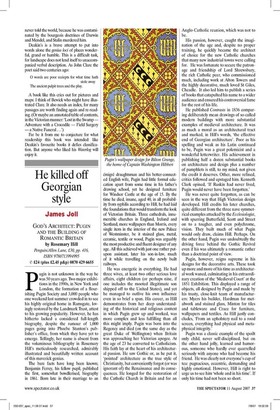He killed off Georgian style James Jell GOD'S ARCHITECT: PUGIN
AND THE BUILDING OF ROMANTIC BRITAIN by Rosemary Hill Penguin/Allen Lane, £30, pp. 416, ISBN 9780713994995 £24 (plus £2.45 p&p) 0870 429 6655 pugin is not unknown in the way he was 50 years ago. Two major exhibitions in the 1990s, in New York and London, the formation of a flourishing Pugin Society and 3,000 people who one weekend last summer crowded in to see his highly original home in Ramsgate, lovingly restored by the Landmark Trust, attest to his growing popularity. However, he has hitherto lacked a considered full-length biography, despite the rumour of 1,000 pages going into Phoebe Stanton's publisher's office, from which they have yet to emerge. Tellingly, her name is absent from the voluminous bibliography in Rosemary Hill's meticulously researched, admirably illustrated and beautifully written account of this maverick genius.
The bare facts have long been known; Benjamin Fen-ey, his fellow pupil, published the first, somewhat bowdlerised, biography in 1861. Born late in their marriage to an émigré draughtsman and his better-connected English wife, Pugin had little formal education apart from some time in his father's drawing school, yet he designed furniture for Windsor Castle at the age of 15. By the time he died, insane, aged 40, in all probability from syphilis according to Hill, he had laid the foundations that would transform the look of Victorian Britain. Three cathedrals, innumerable churches in England, Ireland and Scotland, more wallpapers than Morris, every single item in the interior of the new Palace of Westminster, be it stained glass, metal, ceramic, textile or wood, Pugin was arguably the most productive and fluent designer of any age. All this achieved with just one rather putupon assistant, later his son-in-law, much of it while travelling on the newly built railways.
He was energetic in everything. He had three wives, at least two other serious love affairs, eight children (or perhaps nine, if one includes the mooted illegitimate son shipped off to the United States), and yet he managed to outlive his own influence even in so brief a span. His career, as Hill demonstrates from her deep understanding of the historical and religious context in which Pugin grew up and worked, was more complex and less fulfilling than all this might imply. Pugin was born into the Regency and died (on the same day as the great Duke of Wellington) when Britain was approaching her Victorian apogee. At the age of 23 he converted to Catholicism. His faith lay at the heart of his architectural passion. He saw Gothic or, as he put it, 'pointed' architecture as the true style of Christianity, but conveniently forgot (or was ignorant of) the Renaissance and its consequences. He longed for the restoration of the Catholic Church in Britain and for an Anglo-Catholic reunion, which was not to be.
His passion, however, caught the imagination of the age and, despite no proper training, he quickly became the architect of choice for the new Catholic churches that many new industrial towns were calling for. He was fortunate to secure the patronage and friendship of Lord Shrewsbury, the rich Catholic peer, who commissioned much, including work at Alton Towers and the highly decorative, much loved St Giles, Cheadle. It also led him to publish a series of books that catapulted his name to a wider audience and ensured his controversial fame for the rest of his life.
He published Contrasts in 1836 comparing deliberately mean drawings of so-called modern buildings with more substantial examples of medieval architecture. It was as much a moral as an architectural tract and marked, in Hill's words, `the effective end of Georgian architecture'. Poor as his spelling and weak as his Latin continued to be, Pugin was a great polemicist and a wonderful letterwriter. His achievement in publishing half a dozen substantial books on architecture and design plus a number of pamphlets is still, to my mind, not given the credit it deserves. Other, more refined, critics followed and upstaged him Kenneth Clark opined, 'If Ruskin had never lived, Pugin would never have been forgotten.'
He was never quite forgotten, as can be seen in the way that High Victorian design developed. Hill credits his later churches, quite different from the three nave symmetrical examples attacked by the Ecclesiologist, with spurring Butterfield, Scott and Street on to a tougher, and even polychrome, vision. They built much of what Pugin would only draw, claims Hill. Perhaps. On the other hand, Pugin was undoubtedly the driving force behind the Gothic Revival even if his was ultimately a romantic rather than a doctrinal point of view.
Pugin, however, reigns supreme in his designs for the decorative arts. These took up more and more of his time as architectural work waned, culminating in his extraordinary creation of the 'Medieval Court' at the 1851 Exhibition. This displayed a range of objects, all designed by Pugin and made by his trusty, close-knit team of manufacturers: Myers his builder, Hardman for metalwork and stained glass, Minton for tiles and tableware and Crace for furniture, wallpapers and textiles. As Hill justly concludes, 'From an upholstery nail to a rood screen, everything had physical and metaphysical integrity.'
Pugin was a classic example of the spoilt only child, never self-disciplined, but on the other hand jolly, learned and humorous, someone who hardly ever quarrelled seriously with anyone who had become his friend. He was clearly not everyone's cup of tea: pugnacious, eccentric, demanding and highly emotional. However, Hill is right to urge us to see him 'whole and in his time'. If only his time had not been so short.









































 Previous page
Previous page